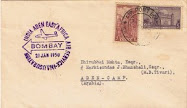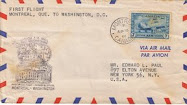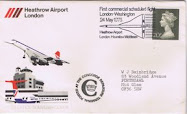For various reasons I was not able to update my blog for the last 4 months. But I'm back. My apologies to all who have been following my blog. I hope to update regularly so keep visiting to read the fascinating history of Aviation as narrated through Philately.
The quest for controlled flight filled the imagination of inventors through the centuries. Early balloons were not truly navigable so there were constant experiments to improve maneuverability of balloons. Some of these included elongating the balloon's shape and, using a powered screw to push it through the air. And thus balloons slowly developed into airships or drigibles from the French (diriger to direct plus -ible), meaning "directable" or steerable. This was another milestone in conquering the air.
The first airships were called dirigible balloons. Over time, the word balloon was dropped from the phrase. In modern usage, balloon refers to any buoyant aircraft that generally relies on wind currents for horizontal movement, and usually has a mechanism to control vertical movement.
The main types of airship are non-rigid (or blimps), semi-rigid and rigid. All these are navigable airships capable of being directed, steered and propelled through the air using rudders and propellers or other thrust. Unlike other aerodynamic aircraft such as fixed-wing aircraft and helicopters, which produce lift by moving a wing, or airfoil, through the air, aerostatic aircraft, such as airships and hot air balloons, stay aloft by filling a large cavity, such as a balloon, with a lifting gas.
Credit for the construction of the first navigable full-sized airship goes to French engineer, Henri Giffard, who, in 1852, attached a small, steam-powered engine to a huge propeller and chugged through the air for seventeen miles at a top speed of five miles per hour.
Henri Giffard and his airship shown on a Cuban stamp of 2000.
A non-rigid airship comprises of a gas-filled container and a car with a motor and propeller suspended beneath. Semi-rigid airships are slightly larger and have some form of internal support such as a fixed keel. Rigid airships with full skeletons, such as the huge Zeppelin transoceanic models, all but disappeared after several high-profile catastrophic accidents during the mid-20th century.
In 1872 Stanislas Charles Henri Dupuy de Lôme (15 October 1816 – 1 February 1885), a French naval architect launched a large limited navigable balloon.
The Dupuy de Lôme airship was 36 meters in length, 14.84 meters in diameter, 29 meters wide, and had a total volume of 3,454 cubic meters. It was powered by a 2 horsepower (1.5 kW) engine, providing a speed of between 9 to 11 km/h. The basket under the balloon could carry eight, several operating the balloon and others observing. She was the first operational airship, and was employed during the last days of the Franco-Prussian war.
Airships were the first aircraft to enable controlled, powered flight, and were widely used before the 1940s, but their use decreased over time as the capabilities of airplanes far surpassed those of airships besides the safety of airships was also questioned.
Airships are still used today in certain niche applications, such as advertising, tourism, camera platforms for sporting events, and aerial observation platforms, where the ability to hover in one place for an extended period of time outweighs the need for speed and maneuverability.
Another airship pioneer was Paul Haenlein (17 October 1835 in Cologne — 27 January 1905 in Mainz) was a German engineer and flight pioneer. He flew in a semi-rigid-frame dirigible with an internal combustion engine running on the coal gas used to inflate the envelope over Vienna, the first use of such an engine to power an aircraft in 1872.
Another airship pioneer was Paul Haenlein (17 October 1835 in Cologne — 27 January 1905 in Mainz) was a German engineer and flight pioneer. He flew in a semi-rigid-frame dirigible with an internal combustion engine running on the coal gas used to inflate the envelope over Vienna, the first use of such an engine to power an aircraft in 1872.
Stamp issued by St. Thome & Principe showing The Paul Haenlein airship.
Other pioneers were Albert & Gaston Tissandier French brothers. Gaston was a French chemist, meteorologist, aviator and editor. Adventurer could be added to the list of his titles, as he managed to escape besieged Paris by balloon in September 1870. In 1883, Tissandier fitted a 1.5 hp Siemens electric motor to an airship, thus creating the first electric-powered flight.
Stamp issued by Liberia showing theTissandier airship.
Brothers Albert & Gaston Tissandier depicted with their airship on a Cuban stamps issued in 2000
The first fully controllable free-flight was made in a French Army airship, La France, by Charles Renard and Arthur Constantin Krebs in 1884. The 170 ft (52 m) long, 66,000 cu ft (1,900 m3) airship covered 8 km (5.0 mi) in 23 minutes with the aid of an 8.5 hp (6.3 kW) electric motor,and a 435 kilograms (960 lb) battery. In 1884 and 1885, it made seven flights. This was probably the first controlled, sustained flight by a lighter-than-air craft.
Cuban stamp issued in 2000 showing Charles Renard & Arthur Krebs and their Airship
The first flyable rigid airship was created by David Schwarz (December 20, 1852,– January 13, 1897, a Jewish Hungarian aviation pioneer. It was also the first airship with an external hull made entirely of metal. He began construction late 1892, with industrialist Carl Berg supplying the aluminum and necessary funding.However, his first airship built in late 1892 exploded while the gas was being filled.
Construction on his next airship started in 1895. The pieces were produced in Carl Berg's Eveking Westphalia factory and under the direction of Schwarz, assembled in Berlin. A gondola, also of aluminum, was fixed to the framework. Attached to the gondola was a 12 horsepower (8.9 kW) Daimler engine that drove aluminum propellers. One of the propellers was used to steer the craft. The airship was first filled with gas on 1896-10-09 and tested, but the results were not satisfactory because the hydrogen gas was not of the required quality and did not provide sufficient lift. Gas with that quality could not be produced until 1897-01-13, the day of Schwarz's death.
 The airship was tested with partial success at Tempelhof near Berlin, Germany, on November 3, 1897 when it lifted off at 15:00 At about 130 metre altitude the driving belt slipped off the left propeller, causing partial loss of steering, the ship "turned broadside to the wind, and the forward tether broke free. As the ship drifted up to 510 metres the belt slipped off the right propeller, thus losing all steering. The pilot then opened the newly fitted gas release valve and landed safely, but the ship turned over and collapsed.
The airship was tested with partial success at Tempelhof near Berlin, Germany, on November 3, 1897 when it lifted off at 15:00 At about 130 metre altitude the driving belt slipped off the left propeller, causing partial loss of steering, the ship "turned broadside to the wind, and the forward tether broke free. As the ship drifted up to 510 metres the belt slipped off the right propeller, thus losing all steering. The pilot then opened the newly fitted gas release valve and landed safely, but the ship turned over and collapsed.Stamp issued by hungary in 1967 showing David's Schwarz's Airship



















2 comments:
Any aero-philately 'artefacts' from USSR's period you could see HERE...
rare stamp up for grab.
http://cgi.ebay.in/DEUTFCHES-REICH-HURRY-HURRY-STAMP-UP-FOR-SALE_W0QQitemZ230446662059QQihZ013QQcategoryZ699QQssPageNameZWDVWQQrdZ1QQcmdZViewItem#ht_500wt_975
Post a Comment